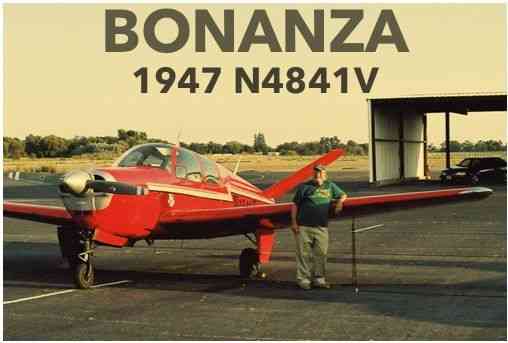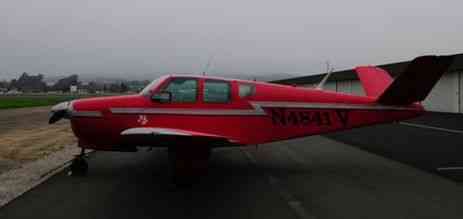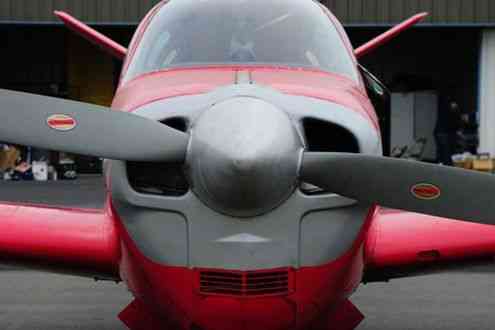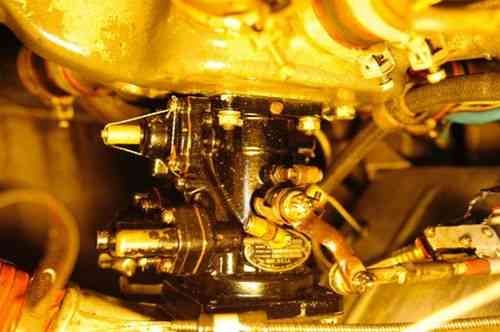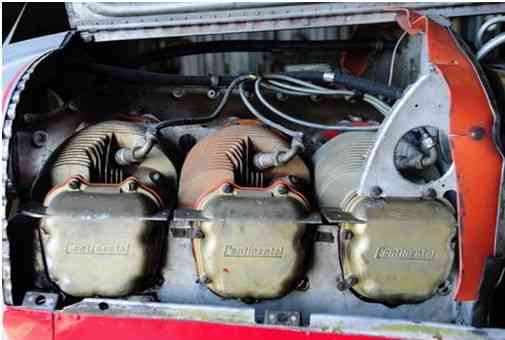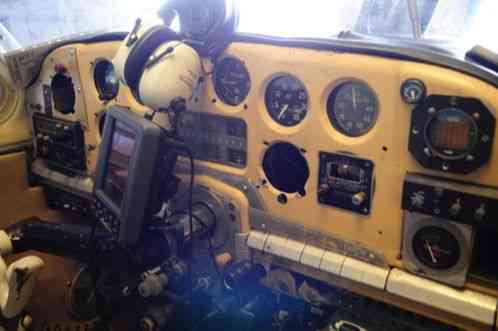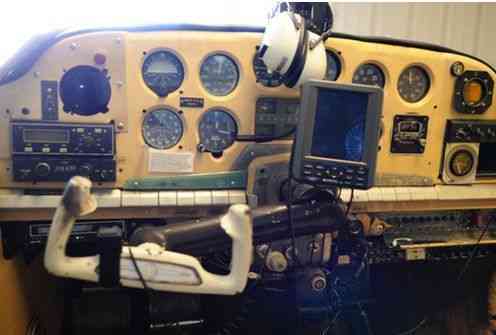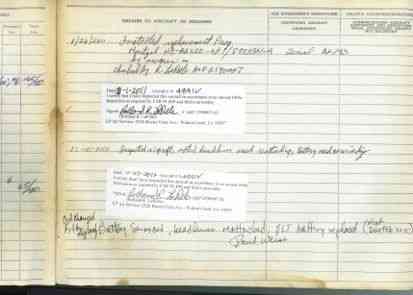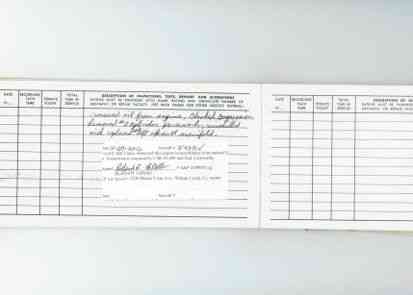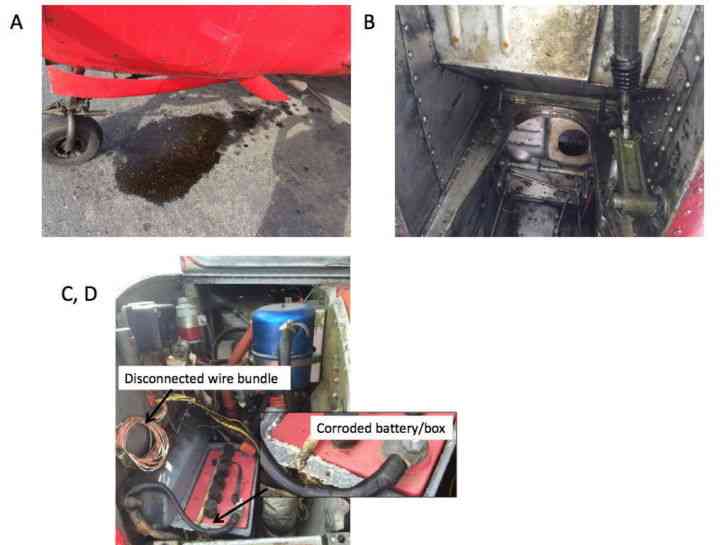“Oil leak, Hail damage to Ruddervators from 30 years ago but flown regularly since. Last airframe.
Item specifics
| Used |
| “Oil leak, Hail damage to Ruddervators from 30 years ago but flown regularly since. Last airframe and log entries (see pics) from 2012. Last valid airworthiness certificate from 2012 or 2013. Last flown in October 2014. Hangared since 1991 up until February 2015.” |
| Make: | Beech | model: | 35 |
| Model Year: | 1947 (or maybe 1953 -- we"re not certain) |
This was my father’s Bonanza. He died in November of 2014. He had last flown the plane the month prior. I’ve heard that it has leaked oil for a couple years. He just would always throw a quart or two in before a trip. There was a pan with a few quarts in it on the floor below the engine when I took it out of the hanger in February (2015). It had been hangared since around 1991 or so. He would always fix things himself. If he couldn’t do it, it didn’t get done.
The most recent logbook entries (for airframe and engine) we could find are shown. (2012). It does NOT have a current airworthiness certificate. It is not known how much effort or money is required to get one, but estimates so far range between $3,000 and $4,500. That’s why we’re selling so cheap.
My dad rebuilt the plane from a wreck in the late 1960s to early 1970s. He finished when I was 10 (1971). We’re not sure whether this is a 1947 or 1954. I have flown as a passenger in this plane all my life. It cruises at 175 to 180 mph and is loud, but smooth. The local FAA mechanic at the airport at which it is tied down won’t issue a ferry permit due he says to the hail damage which the ruddervators suffered some 30 years ago. Apparently, sometime in the 1980s they changed the rules and all the airworthiness certificates issued since then allowed it to be grandfathered, but the local certified mechanic at Livermore won’t. So you’ll have to load it onto a truck when you buy it or take over the tiedown payments. Please feel free to call if you have any questions. (505) 259-5683 is my cellphone number. I live in Clearlake, CA — approx. 4 hours’ drive north of where the plane is tied down. If you’re ready to come and see it, give me at least a single day’s notice, and I can come and meet you.
• Location: Livermore, CA municipal airport, at the tiedowns just east of the temporary parking to the east of the fuel pumps. • Registration Number: N4841V
Equipment: AIRFRAME: 5500 TT, SN D-784 ENGINE: 915 TSMOH, Continental E-185-8 PROP: NEW, Hartzell Two Blade
Avionics: GPS: Lowrance Airmap 2000 (not included because I can’t find it; if I find it, it’s yours with the plane) NAV/COM: Narco 120 TRANSPONDER: Bendix/King KY 97A
Exterior: Red with silver and black trim, recently painted Interior: Cream vinyl and sheepskin paneling and seating with tan sidewalls
Below is a report .pdf which was written by a fellow my sister hired for only $50 to evaluate the plane. It seem pessimistic to some of the people who have actually seen the plane, but I include it here so you can judge for yourself. In particular, the plane’s been flying for 30 years on those ruddervators that the report claims are not airworthy. Obviously, some FAA inspectors have approved of them in for many years.
All sales final. You are responsible for reading all this stuff I’ve taken the time to write. Please do so before you bid.
Date: March 23, 2015Re: Condition of Beech Bonanza N4841VDear executrix,
I have completed a cursory examination of Beech Bonanza N4841V (Serial Number D748) in order to provide you with some guidance regarding its general condition.The inspection was conducted on the aircraft as it sat on the ramp at Livermore Municipal Airport and consisted of visual examination of fuselage, stabilators, ruddervators, wings (including the wheel wells), ailerons, landing gear and engine compartment. Control surfaces were gently moved whenever possible. I took pictures (labelled A- and corresponding to text) during the walk-around and have included them to illustrate some of the more problematic areas.
I could not access the interior structures that were not immediately visible without removal of numerous inspection panels. Also, I was not able to run the engine, jack the aircraft to test the landing gear, nor turn on the electrical systems to assess the functionality of those systems requiring electricity (e.g. the radios & instrument panel). This inspection did not include a review of the aircraft logbooks nor weight & balance data. Due to the limited scope of the inspection, there are likely additional unidentified issues beyond those listed below:
Engine, propeller and engine compartment: Engine has extensive oil leak and there is a large puddle of oil underneath the aircraft (A); appears to be coming from multiple areas. Engine and engine compartment is covered in oil and grime (B). Multiple wires disconnected and dangling in engine compartment (e.g. exhaust gas temperature probes) and at firewall (large bundle of wires from unknown instruments) (C). Battery acid has leaked and corroded the battery box (D). Spark plugs are corroded. Crankshaft may have a bad bearing since pushing/pulling on the propeller along longitudinal axis reveals a significant amount of travel. Propeller blades appear to be in good shape; however, I could not access the prop hub.
Fuselage: Extensive oil coverage inside engine compartment and on belly; oil as entered the interior through riveted joints along sides of fuselage behind cabin (E). There appears to be black, burnt oil in the areas exposed to hot engine exhaust (F). There are numerous small dents on the top of the aircraft fuselage, which may be due to hail damage. When viewed from inside, there is likely evidence of corrosion (white spots) on the skins located aft of the baggage compartment (G).
Rear empennage (stabilators and ruddervators): Multiple, sometimes overlapping, sheet metal repairs (patches) on trailing edges of ruddervators are of questionable quality and need further assessment (H, I). There are cracks on the passenger-side ruddervator-to-trim tab (outboard) hinge region (J). There may also be a crack on the passenger-side stabilator-to-ruddervator hinge point (K); however, given the current paint condition, this was difficult to tell if this was just the paint cracking or if the cracks went through the sheetmetal.
Landing gear: All three landing gear struts will require servicing and/or overhaul. The nose gear strut is completely collapsed (L), while the left and right main gear struts appear seized (I did not observe any shock absorbing action upon testing.) All three tires exhibit some cracking or degradation and need to be replaced (M).
Wings and ailerons: There are repairs to the top skins of both right and left wings (N), and repairs to the stringers above wheel well. One of these repairs utilized pop-rivets which may or may not be airworthy (O). The top skin of the left aileron is dented inwards, which imparts a significant twist to the left aileron (P). This results in the trailing edge of the aileron not aligning with the trailing edge of the wing (Q, compares alignment of left and right side ailerons). There is evidence of rubbing/chafing between the wing and the aileron at the lower trailing edge of the left wing as well as at the aileron hinges.
Cabin interior: The interior is in poor condition overall. There are three empty spaces on the instrument panel (R). Many of the wire bundles from behind the instrument panel are not secured (S). Much of the plastic instrument panel cover, the plastic knobs and plastic switches are deteriorated or broken (T). Vinyl headliner is not secured to the ceiling along passenger side (U). Wooden floorboards are delaminated (front and rear). The windscreen has cracks emanating from a few of the mounting screws.
In my opinion, there are enough big repairs (i.e. engine, wings, landing gear, empennage, ailerons, instrumentation & interior) that the best course of action to gain airworthy status for this aircraft would be a ground-up restoration, which could easily exceed the finished value of the airplane.
Current date: 2015-06-03
